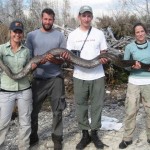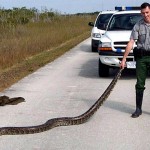Pythons overtake Everglades
In southern Florida, giant snakes change the ecosystem one meal at a time

You’ve probably been “as hungry as a bear.” But in the Everglades in southern Florida, you’ll sound more local by comparing your hunger to a python. In this region’s swamplands, giant snakes called Burmese pythons gobble alligators, birds, raccoons, opossums — even 80-pound deer.
With their ferocious appetites, the snakes have made their presence known to residents and scientists alike. In two new studies, researchers report that where the pythons roam, the numbers of mammals have dropped dramatically. Numbers of deer, bobcats, fox and rabbits are far below what they were 20 years ago. That was before the pythons had arrived.
Federal officials think Burmese pythons were first released into the rugged wilds of the Everglades 15 to 30 years ago. Since then, the snakes — native to Asia — have gotten comfortable in their new home. Most of the 30,000 or so that now slither through the swamps were probably born there. Others come from pet owners who released the snakes when they got too big.
Scientists know about the pythons’ eating habits because of the wide variety of animals found in the snakes’ stomachs, says Michael Dorcas. He led one of the new studies. “But until now, there hadn’t been any indication that the snakes were altering the ecosystem,” he told Science News. An ecologist at Davidson College in North Carolina, Dorcas studies how organisms interact with each other and their ecosystem. (An ecosystem includes all the living things, like animals and plants and other organisms, in a particular region.)
The Everglades’ wet fields, mangrove forests and cypress groves are hard for humans to explore. To count animals, Dorcas and his colleagues had to get creative. They took to the roads. On 313 nights between 2003 and 2011, they drove around counting all of the mammals — dead or alive — they saw. Then, they compared their observations to animal counts made from the road during 51 nights in the 1990s.

Rabbits were among the region’s most common animals in the 1990s. In the new count, none were seen. The numbers of opossums and raccoons had dropped by 98 percent between the two counts. So if the scientists had counted 100 of the animals in the 1990s, they counted only two in the 2000s. Across the board, the numbers of small and medium-sized mammals had dropped.
Biologist Joshua Holbrook works at Florida Atlantic University in Davie. He helped out on another recent study of the region. And he and his collaborator Thomas Chesnes, of Florida’s Palm Beach Atlantic University, turned up similar results, Holbrook says. They also drove around southern Florida to estimate how the ecosystem has changed. Over four nights of driving on Everglades roads, the scientists counted only nine mammals. On another stretch of driving, over five nights, they didn’t count any.
“Within the Burmese python’s Florida range … it seems that the sighting of any mammal (especially small mammals) is a rare occurrence,” Holbrook and Chesnes reported in their study.
Efforts are underway to rescue the Everglades from the pythons. Government officials have already removed more than 1,000 Burmese pythons from the area. Still, that has barely made a difference. In January 2012, the U.S. Department of the Interior officially made it illegal for people to bring Burmese pythons — or other giant snakes like anacondas and some constrictors — into the country.
And the Florida Fish and Wildlife Conservation Commission has just started holding what they call “amnesty” days. On these days, pet owners can give up pythons and other pets that are not native to Florida. The agency has begun organizing occasional, one-day events around the state so that people can surrender their exotic pets free of charge. No questions will be asked. “Every attempt will be made to place all healthy animals with qualified adopters,” this Florida commission says. Its programs will accept nonnative reptiles, amphibians, birds, fish, mammals and invertebrates.
But forget Fido and Puss. The program will not find new homes for conventional pets like dogs, cats and ferrets.
POWER WORDS (adapted from the New Oxford American Dictionary)
ecosystem A biological community of interacting organisms and their physical environment.
python A large, heavy-bodied, nonpoisonous constrictor snake.
mammal Warm-blooded animals that have backbones and often possess hair or fur. Females secrete milk for the nourishment of the young.
biology The study of living things.







